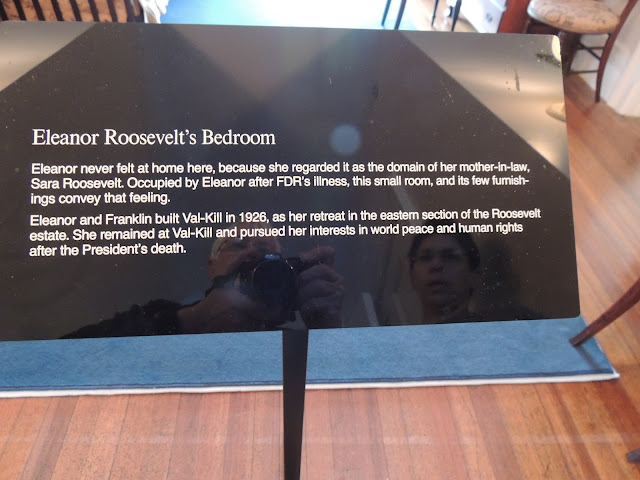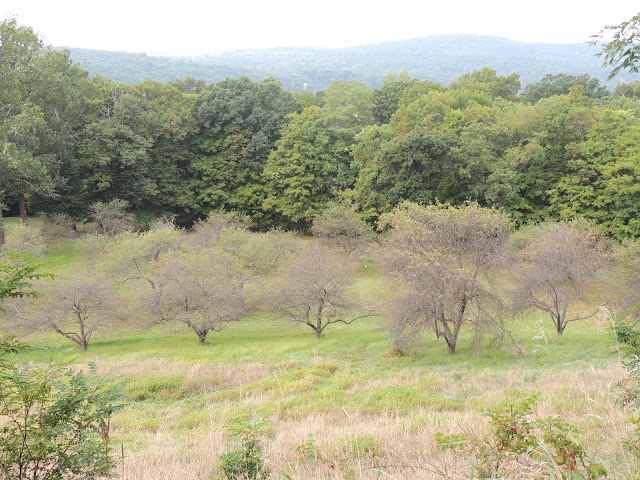To truly understand and appreciate Springwood, you need to know a bit about FDR's mother, Sara, and her influence on him. This is the place he called Home, his entire life. It amazes me that he had so much empathy and respect for the working class, having been raised by Sara.
https://www2.gwu.edu/~erpapers/teachinger/glossary/roosevelt-sara-delano.cfm
Sara Delano Roosevelt (1854 - 1941)
![[picture: FDR and Sara Delano Roosevelt, Hyde Park, 1933]](https://www2.gwu.edu/~erpapers/teachinger/images/fdrl_fdr-sara_09-1767a.jpg) Sara Delano Roosevelt (SDR) was the daughter of Warren Delano, a wealthy merchant who made a fortune in the tea and opium trade in China, and after losing it, returned to make a second fortune. Sara grew up in Hong Kong from 1862-65 and in Algonac, the family estate on the Hudson River near Newburgh, New York. She was educated at home, except for a short period in 1867 when she attended a school for girls in Dresden, Germany. Sara Delano was tall and radiantly beautiful and had many suitors. At twenty-six, to the surprise of her friends, she married James Roosevelt, a widower who was twice her age. By all accounts, she found great happiness in her marriage and in life on her husband's Hyde Park, New York, estate. After the birth of Franklin Delano Roosevelt on January 30, 1882, she was advised to have no more children. She became absorbed in raising her only son, reading to him, giving him baths, and directing his activities herself rather than leaving these tasks to servants. After the death of her husband in 1900, she became still more single-mindedly focused on her son and his welfare. She moved temporarily to Boston when he attended Harvard in order to be near him. No mother could have been more devoted. She was also strong willed, controlling, opinionated, and inflexible. She does not seem to have been enthusiastic about any of the young women her son courted and, when he fell in love and proposed marriage to Eleanor Roosevelt, she tried to change his mind and insisted that the engagement be kept secret for a year.
Sara Delano Roosevelt (SDR) was the daughter of Warren Delano, a wealthy merchant who made a fortune in the tea and opium trade in China, and after losing it, returned to make a second fortune. Sara grew up in Hong Kong from 1862-65 and in Algonac, the family estate on the Hudson River near Newburgh, New York. She was educated at home, except for a short period in 1867 when she attended a school for girls in Dresden, Germany. Sara Delano was tall and radiantly beautiful and had many suitors. At twenty-six, to the surprise of her friends, she married James Roosevelt, a widower who was twice her age. By all accounts, she found great happiness in her marriage and in life on her husband's Hyde Park, New York, estate. After the birth of Franklin Delano Roosevelt on January 30, 1882, she was advised to have no more children. She became absorbed in raising her only son, reading to him, giving him baths, and directing his activities herself rather than leaving these tasks to servants. After the death of her husband in 1900, she became still more single-mindedly focused on her son and his welfare. She moved temporarily to Boston when he attended Harvard in order to be near him. No mother could have been more devoted. She was also strong willed, controlling, opinionated, and inflexible. She does not seem to have been enthusiastic about any of the young women her son courted and, when he fell in love and proposed marriage to Eleanor Roosevelt, she tried to change his mind and insisted that the engagement be kept secret for a year.
After Franklin and Eleanor's marriage on March 17, 1905, SDR planned every facet of their lives. She built a double townhouse at 49 East 65th Street in Manhattan, one half for them, one half for herself. Later, she bought a cottage for them right next to her own on the island of Campobello where she spent her summers. When children began to arrive, she was there with advice on how to rear them and she often undermined parental discipline by spoiling them. The Delanos were a close and supportive family, unlike ER's mother's family, the Halls, and ER at first appreciated her mother-in-law's attention. She felt insecure about her role as a mother and relied on Sara's direction. She tried to please Sara and win her affection. But Sara was aloof and emotionally focused on her son, Franklin. ER soon found her mother-in-law's domination oppressive and struggled to achieve her independence. As she developed her own interests, friends, and activities, and in the1920s emerged as a political leader in her own right, she was able to escape Sara's authority. At times FDR and ER became allies in opposing Sara's will. After polio paralyzed FDR's legs, Sara wanted FDR to retire to Hyde Park and live the rest of his life as a country gentleman, but ER strongly supported FDR's desire to return to politics. Sara hated politics, hated publicity, hated newspapermen, and was prejudiced against any individual or group not belonging to her elite social class. Ironically, the public lives of both her son and her daughter-in-law exposed her to much that she found distasteful. She retained her dignity, her pride in her family and lineage, and her strong opinions, however, and remained in charge of Springwood, the estate in Hyde Park that she had shared with her husband and then with FDR, until her death. FDR never created a home with ER that was separate from his mother's home and even after Sara's death FDR refused to make any changes in the way the house was furnished or decorated.
After Sara died on September 7, 1941, ER wrote in her column that Sara's "strongest trait was loyalty to her family. . . . She was not just sweetness and light, for there was a streak of jealously and possessiveness in her when her own were concerned."(1) ER recognized Sara's fierce strength, but she could not love her. "It is dreadful," she wrote a friend, "to have lived so close to someone for 36 years & feel no deep affection or sense of loss. It is hard on Franklin however."(2)
Notes:
Sources:
Cook, Blanche Wiesen. Eleanor Roosevelt, Volume One, 1884-1933. New York: Viking Press, 1992.
Cook, Blanche Wiesen. Eleanor Roosevelt, Volume Two, 1933-38.New York: Viking Press, 1999.
Graham, Otis L. and Meghan Robinson Wander. Franklin Roosevelt, His Life and Times. Boston: G.K. Hall & Co., 1985.
Lash, Joseph P. Eleanor and Franklin. New York: W. W. Norton & Company, 1971.
Springwood Front Entrance
Everybody needs a cannon on their front porch, there were two.
The parlor
The entrance hall
FDR was always fascinated with birds and even as a child, he became an authority. He hunted the birds and brought them home and preserved them. This cabinet contains the remains many of these birds.
They are restoring the original ramps.
Their phone was in a cubby next to the stairs.
The stairs to the second floor. Behind the stairs there is a dumbwaiter that was enlarged to carry Franklin and his wheelchair. FDR would pull himself and his chair up to the second level manually. Because he never wanted to exhibit any weakness, he had developed his upper body to the extent that he could lift himself in the dumbwaiter using his arms.
Next to the stairs
FDR chose this room in 1915 because of it's sweeping view of the Hudson river and the mountains. Eleanor and Franklin shared this room until the onset of his polio.
Note the telephone on the wall next the bed was a coded direct line to the White House during WWII. Franklin's Scottie, Fala's leash and blanket lay on the chaise at the foot of the bed.
Eleanor had simpler needs.

Another bedroom
The view in the back
The Hudson River
Orchards
The grounds
The Stables
The tack room
During WWII the estate was guarded by the military and the secret service
Some period pieces are displayed and there are men dressed in military and secret service clothes.
The gardens
Franklin and Eleanor grave sites



















































No comments:
Post a Comment